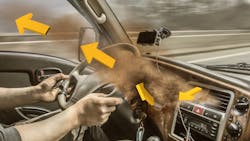Make health and safety a priority this spring
For many, the arrival of spring brings runny noses, itchy eyes and scratchy throats. As the weather starts to improve after another long winter, it’s time for the annual reminder that the occupants of a heavy duty vehicle’s cabin are under constant assault from allergens, pollutants and other airborne contaminants.
A cabin air filter is a front line of defense against these irritants before they enter the cab, where inhaling them can lead to a range of health issues that are not limited to seasonal allergies. These ailments include headaches, nausea and the worsening of pre-existing respiratory conditions such as asthma.
These problems can be magnified when traveling in a vehicle that does not have proper air circulation or appropriate filtration. A reliably functioning cabin air filter will provide a steady stream of clean, contaminant-free air to the driver and passengers. This can be especially crucial for long-haul, over-the-road operators who can spend upwards of 10 hours a day in their cabs. Many drivers often sleep in their cabin space as well, so the need to deliver clean air becomes even more critical to maintaining a healthy environment inside the vehicle.
The air we breathe
The importance of protecting the well-being of the driver should never be overlooked. Consider that the air inside the passenger cabin can often be more polluted than the air outside. This is due to contaminants such as mold spores, bacteria, pollen, diesel soot, dirt, dust, exhaust gases and smog entering the vehicle through the air conditioning, heating and ventilation systems.
When these systems draw in outside air and the windows are closed, contaminants become concentrated inside the cab. Microorganisms can then begin to accumulate, potentially multiplying to concentrations of between five to eight times higher than normal.
A poorly ventilated cabin can also become covered in a fine layer of dust as contaminants settle on all of the surfaces and remain in the cabin even longer. Most drivers and passengers would be surprised to see the dirt, dust and debris that accumulates over even a short amount of time, let alone the allergens that can pass through the ventilation system when cabin air filtration is insufficient.
Putting safety first
Fleets who stress the importance of maintaining safe working conditions should also understand how clean cabin air contributes to driver safety. Breathing cleaner air and having a properly functioning ventilation system at their disposal may help drivers stay more alert so they can finish their routes without incident.
Cleaner cabin air can also prevent distractions like sneezing, blurry vision and other allergic reactions caused by pollen and other contaminants entering the cabin. Some think there are fewer allergens in the air during colder months, but there are plenty of perennial allergens to deal with year-round. Ragweed pollen and mold spores in particular, for example, are at elevated levels from late summer to mid-fall.
What are the warning signs that a cabin air filter needs attention? When it becomes excessively dirty, it can cause a couple of noticeable symptoms:
- Poor air flow – Vents will blow with noticeably less force, reducing the overall cooling capacity of the air conditioning (A/C) system and also placing an additional strain on the A/C blower motor.
- Unusual odor – A dusty, dirty or musty smell will come from the vents when the air circulation system is turned on, which can create an unpleasant environment for the driver and passengers.
Dual-action cabin air filters are available to alleviate both issues and create the safest, most pleasant environment possible for hard-working drivers. These filters can remove nearly 100 percent of bacteria, dust, pollen and other allergens from incoming air. Activated carbon and baking soda in the media work together to remove volatile organic compounds, such as hydrocarbons and gas emissions, as well as a wide range of nuisance odors. The result is the most pure and most odor-free air in a cabin.
Make the change
Like any other filter in a vehicle, cabin air filters need to be changed at routine intervals to help maintain a healthy driving environment. At minimum, fleets should keep cabin air clean and fresh with a new filter every 12,000 to 15,000 miles. Seasonal replacement to protect against pollutants that occur during different times of the year is recommended for vehicles that regularly experience harsh temperatures or severe climate changes.
Installing a cabin air filter is not a complicated process and should not prevent regular maintenance. In most trucks, the cabin air filter is located under the hood at the outside air intake along the firewall on the passenger side. The filter’s housing is easy to access and often is clearly marked. In many cases a service technician can perform a cabin air filter replacement in 15 to 30 minutes.
Over the past 20 years, several features such as GPS and advanced entertainment systems have become common in today’s trucks. One of the most practical advancements has been the standardization of cabin air filters. Whether the goal is to prevent the spring sniffles, keep harmful contaminants from entering the cabin or eliminate unwanted odors, cabin air filters play a prominent role in ensuring that a professional driver enjoys the safest, healthiest, most pleasant working conditions possible.
Zafar Hussain is a senior product engineer at Luber-finer. He has worked in the filtration industry since 2002 and has multiple patents under his name, including Luber-finer’s Heavy Duty Time Release Technology (TRT) Oil Filter. Since 1936, Luber-finer has provided quality filtration solutions for on-highway trucking applications as well as off-road vehicles, marine, mining, construction, agricultural and more.
